Part of a series of articles titled The Legacy of ANILCA.
Article
K’ezdlagh: Nondalton Ecological Knowledge of Freshwater Fish
By Karen Stickman, Andrew Balluta, Mary McBurney, Dan Young, and Karen Gaul
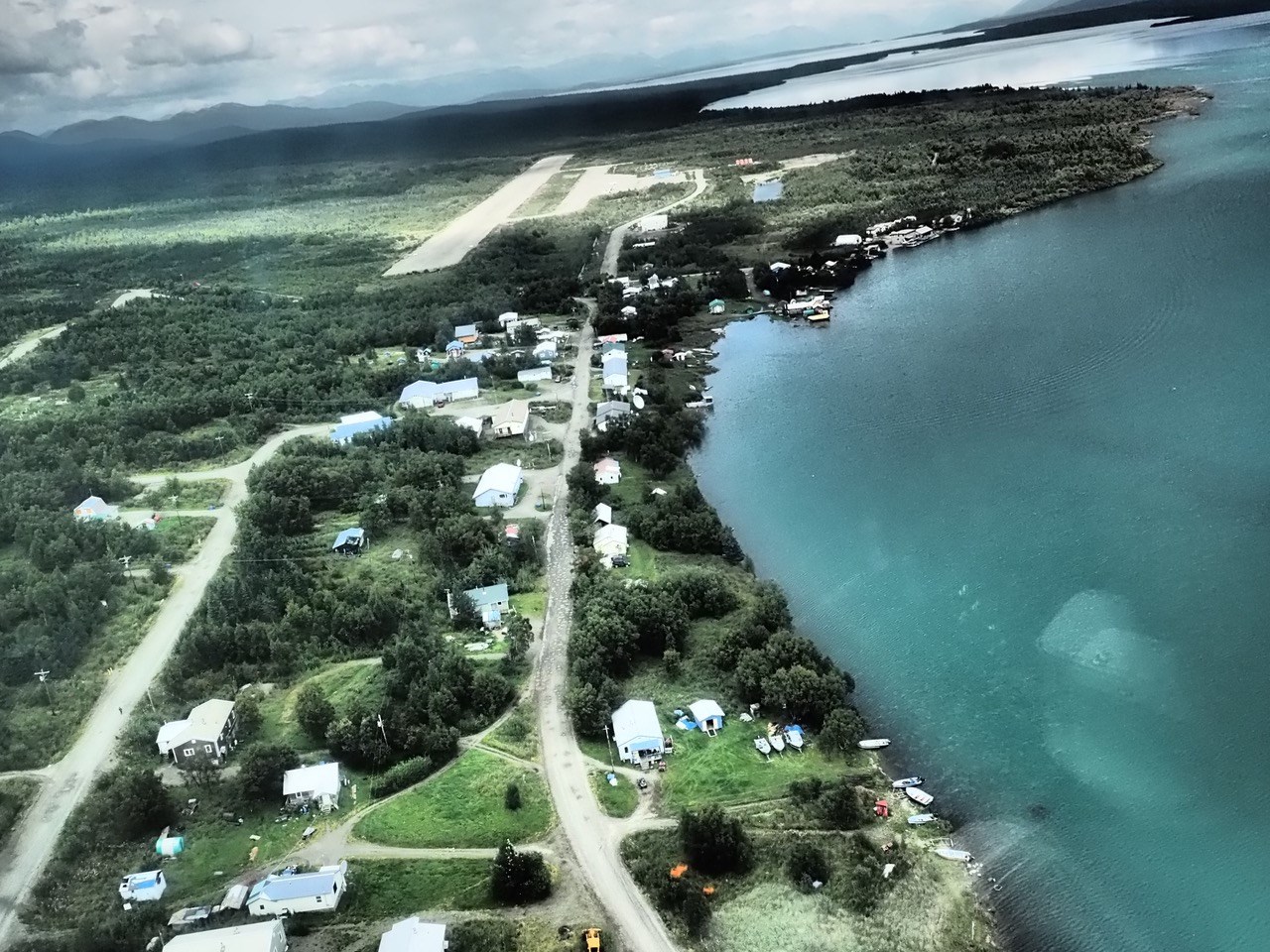
National Park Service photograph, Dr. Carol Ann Woody
Introduction
The village of Nondalton lies along the shores of Sixmile Lake, which flows out of the southwest tip of Lake Clark in Southcentral Alaska. Most residents of Nondalton are Dena'ina Athabascans. People's occupation and use of the area spreads along rivers and shorelines to fish camps, and up the hills to hunting and trapping areas.The village of Nondalton was settled around 1930 by people relocated from Old Nondalton, which was a resettlement (around 1910) of people largely from the village of Kijik (Townsend 1965). Occupation in the Kijik area ranges from AD 1170 to about 1900. Through the centuries, one thread of continuity for the communities in this area is their ongoing use of plant and animal resources for basic subsistence needs.
Lake Clark National Park and Preserve (LACL) was established under ANILCA in 1980. This legislation provided for continued subsistence use on federal lands, which many saw as an innovative step toward protecting Native cultural practices and access to traditional resources (Title VIII). Although outside of the park, the people of Nondalton had a long history of resource use in the entire region. Under ANILCA, Nondalton became one of the Resident Zone Communities (RZC) of Lake Clark National Park and Preserve, and therefore could continue to utilize plant and animal resources.
Section 812 of ANILCA mandates that federal agencies should conduct research on fish and wildlife and the subsistence use of those resources. It emphasizes the need to draw from local knowledge in the research process and to make the results widely available. Those who have interacted with Section 812 of ANILCA mandates that federal agencies should conduct research on fish and wildlife and the subsistence use of those resources. It emphasizes the need to draw from local knowledge in the research process and to make the results widely available. Those who have interacted with and are also the best observers of changes in the resources, climate, and environment over time. Native communities who utilize the resources within the park can inform and educate the broader scientific community, while also providing valuable information on which to base management decisions. In a study carried out recently, knowledge about fish resources held by Native elders and other residents was documented and integrated with other National Park Service research. The present article briefly describes this study, and all information is excerpted from the report K'ezghlegh: Nondalton Traditional Ecological Knowledge of Freshwater Fish (Stickman et al.2003).
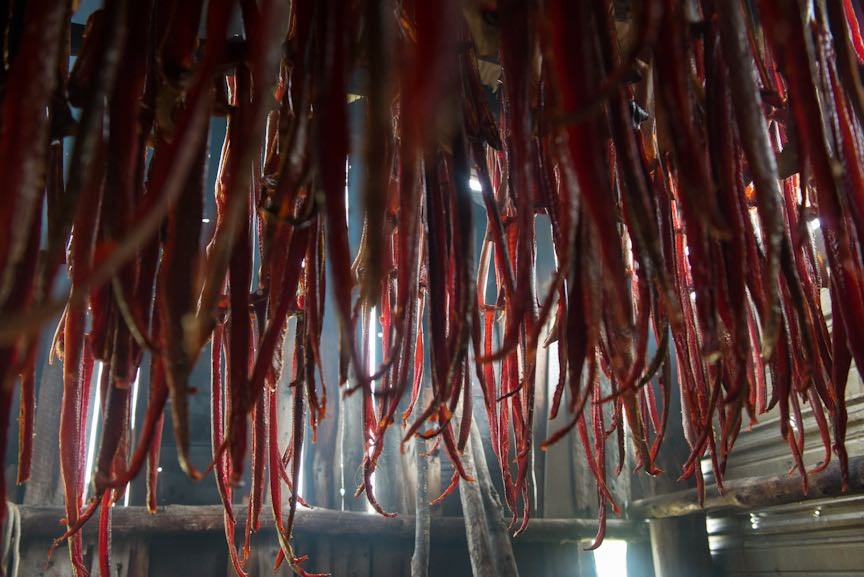
National Park Service photograph, Dr. Carol Ann Woody
Traditional Subsistence Use
The traditional diet of the Inland Dena'ina included birds, land mammals and a variety of fish, each harvested in its season (Behnke 1982; Ellanna and Balluta 1992). During the winter and early spring, people fished for whitefish (hulehga), least cisco (ghelguts'i k'una), burbot (ch'unya) and lake trout (zhuk'udghuzha). After the thaw, they fished for lake trout, Dolly Varden ( qak'elay), whitefish, pike (ghelguts' i), grayling (ch'dat'an) and burbot using nets, traps, and hook and line (Ellanna and Balluta 1992).The summer months from June through the middle of August were primarily devoted to harvesting and preserving sockeye salmon (k'q'uya) using nets, log weirs, and fish traps placed in spawning streams or by spearing from the river banks. Lake trout, whitefish, pike and suckers (duch 'ehdi) were also taken in salmon nets and used as dog food or dried for later use. Prior to the abandonment of Kijik, most of the summer fish camps were located at the outlet of Kijik Lake (Ellanna and Balluta 1992). Contemporary fish camps are primarily located at the head of the Newhalen River at the outlet of Sixmile Lake and scattered along the shores of the Newhalen River, Sixmile Lake and Lake Clark.
Around the beginning of October, people would establish fall fish camps to harvest and dry 'fall fish', which were considered a delicacy. Bright, red, spawned out salmon were caught using barbed fish spears then eaten fresh, or split and dried (Ellanna and Balluta 1992).
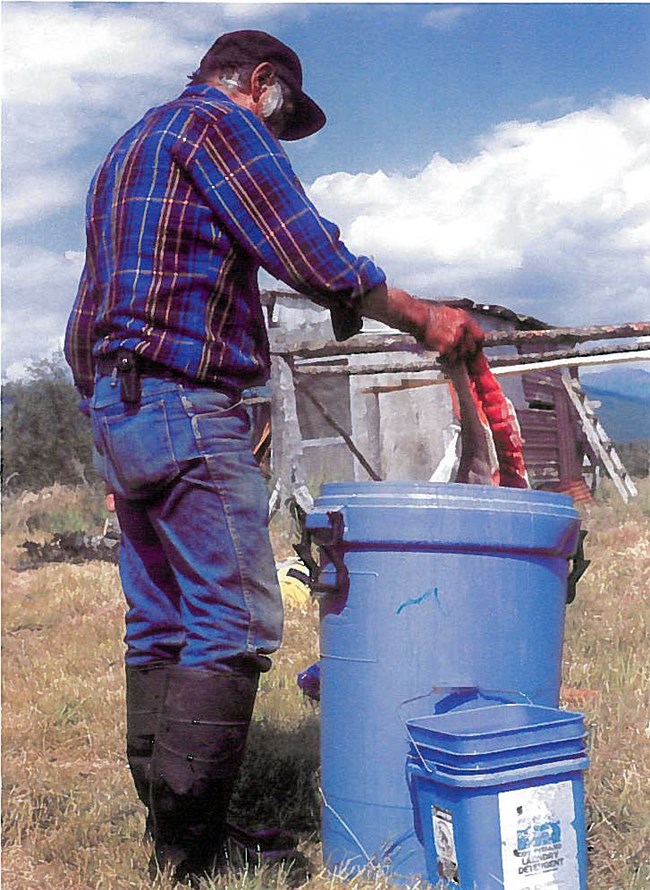
National Park Service photograph, Dan Young
Contemporary Subsistence
While the methods and means for harvesting fish ha e changed over the years with the introduction of new fishing equipment and technologies, fish remain an important source of protein. For the Nondalton Dena'ina, salmon accounts for 65% of the subsistence diet and other freshwater fish comprise another 15% (ADF&G 2002).Lake Clark, Sixmile Lake and their tributaries are sockeye salmon producing systems. K'q'uya, or sockeye salmon, is the primary fish species used by Nondalton residents for subsistence. Pre-spawning sockeye salmon are harvested in Newhalen River, Alexie Creek, Sixmile Lake, and Tazimina River from late June through late July, and at various locations in Lake Clark from late July through the middle of August. Spawned out sockeye salmon, calledgh'elica or redfish, are generally taken from August through October in the Tazimina River, Kijik River, and on beaches and streams tributary to Lake Clark.
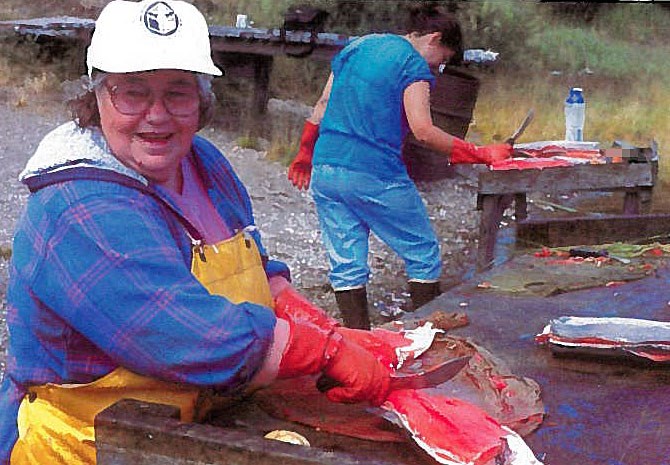
National Park Service photograph, Dan Young
Harvest Mehods
Before the introduction of commercially manufactured gill nets, people used a variety of methods to harvest salmon and other freshwater fish. Seines were used to catch salmon; spears to harvest redfish; and fish traps to capture salmon, trout, whitefish, grayling and pike. Pete Koktelash related that before gill nets were widely available, salmon were caught using fish traps in Alexie Creek, Old Kijik, and Kijik Lake. Andrew Balluta described a weir used near a fish camp at Kijik Lake for capturing fish: . . . they put a fence across the creek, they get fish in there. Fish go up in there and everybody go down there and get whatever fish they need (Stickman et al. 2003:20).In 1959, the State of Alaska banned the use of fish traps for subsistence and commercial fishing (Colt 1999). Seines are another gear type traditionally used for harvesting salmon that are no longer allowed under current State of Alaska fisheries regulations. Gladys Evanoff summarized the concerns expressed by many Nondalton residents: Seining is best way I think. Better than setting [gill] net. You don't waste fish. Just get what you want (Stickman et al. 2003:21). Many residents regard seining as a more efficient and less wasteful fishing method-it does not bruise the fish, is nonlethal, and excess fish can be released.
Harvest Amounts
The amount of fish harvested for subsistence use has greatly declined over the decades, primarily due to the fact that dog teams are no longer a major form of land transportation. In the 1940s, most Nondalton households kept dog teams, which required up to 50 bundles (one bundle equals 40 fish), or 2000 salmon, for the year (Ellanna and Balluta 1992). According to Andrew Balluta, as recently as 15 years ago, families put up 20 to 25 bundles per household. Now, he says, people put up fewer. Based on the harvests reported, respondents had a harvest average between five and sixteen bundles.Subsistence fish camps are no longer occupied throughout the summer months, as in the past, but have evolved into family gathering places where members work for shorter periods of time to catch and put up fish. Nondalton residents suggest that changes in subsistence needs, the increased number of beaver dams altering spawning areas, land ownership patterns, and changing interests and priorities of Dena'ina youth mean less time spent in fish camps.
Observed Changes
One of the most important results of traditional ecological knowledge research has been the observation of fish decline. Residents of Nondalton noted areas such as Kijik Lake, Priest Rock, Alexie Creek, Tazimina River and others where spawning activity had decreased over the years. Several respondents mentioned that the reduced spawning is due to increased beaver damming on the Kijik River.In addition, Nondalton residents have observed an overall decline in salmon returns. The average number of sockeye salmon returning to Lake Clark declined from 1.1 million fish in 1980-1981 (Poe and Rogers 1984) to about 0.2 million 20 years later (Woody 2004). This dramatic reduction in salmon abundance is of great concern to Nondalton residents who worry about the long-term health of sockeye salmon stocks in the Lake Clark/Newhalen River system. All of the people interviewed reported fewer fish than in the past and all first noticed the change in abundance between five and 10 years ago.
Respondents also expressed opinions about the size and quality of the salmon they harvest. Some speculated that differences in size and flesh texture were a result of farm fish mixing with wild fish. Others noticed salmon with abnormal growths and blemishes.
Nondalton residents made many observations about changes in the weather in recent years, including later snow falls, less snow, warmer and wetter winters, and warmer summers. These changes are linked to and affect the timing of fish runs. However, there are a number of changes in the availability of fish resources that Nondalton residents attribute to human-influenced change.
ANILCA resulted in the designation of large areas of land used by the people of Nondalton for hunting and fishing as park land. Since passage of ANILCA in 1980, there has also been dramatic growth of the sport hunting and fishing industries in the Lake Clark region. Almost all of the residents interviewed expressed concern regarding this growth and the potential impacts it may have on the area's fisheries resources. Mike Delkittie explained his concerns regarding the influx of sport fishermen in the Lake Clark area and the impacts of catch-and-release fishing he has observed while subsistence fishing: Lots of sport fishing is going on in Port Alsworth ... We pick up a lot of fish guts in our gill net and three pronged hooks. We have to be careful when picking up the fish because we could get hooked too (Stickman et al. 2003:33).
The issue of sport fishing also raised concerns regarding salmon and trout mortalities resulting from catch-and-release fishing. Andrew Balluta reported that he had observed sport-caught fish that had either been released dead or that had died after being let go: You see dead fish floating down in Newhalen (River) from sport fishing. The fish don't die just because they want to. I notice that quite a bit. It is not just salmon, but trout, too. When they catch and release, a lot of them die. You know, if you catch a fish in the gills, they are dead (Stickman et al. 2003:34). Catch-and-release fishing raises serious ethical questions for many Nondalton residents who view the practice as an irreverent torturing of fish.
The use of jet boats, particularly on small rivers such as the Kijik and Tazimina, is another issue largely related to sport fishing and of great concern to many residents. Jet boats are generally viewed as destructive to salmon spawning areas and as a factor contributing to reduced salmon abundance in small systems. Bill Trefon, Sr., explained that the strong suction generated by higher horse powered jet units creates the greatest problems: Especially in spawning areas where the water is shallow and they blow up the rocks and the eggs and disturb the areas that the fish spawn-where their eggs are (Stickman et al. 2003:35).
Over-fishing in the commercial fish industry was another concern of subsistence users. In 1997, 1998 and 2001, Bristol Bay was declared an economic disaster area due to low salmon prices and below-average returns. Between 1996 and 2001, the number of salmon returning to the Kvichak River system-including Lake Iliamna and Lake Clark-was so low that minimum escapement goals were not met in four out of six years (Bristol Bay Native Association 2002, ADF&G 2002). While numerous hypotheses have been posed by scientists, fishermen, and state and local officials to explain the decline in salmon abundance, over-fishing was mentioned most often by respondents as the reason for reduced salmon runs.
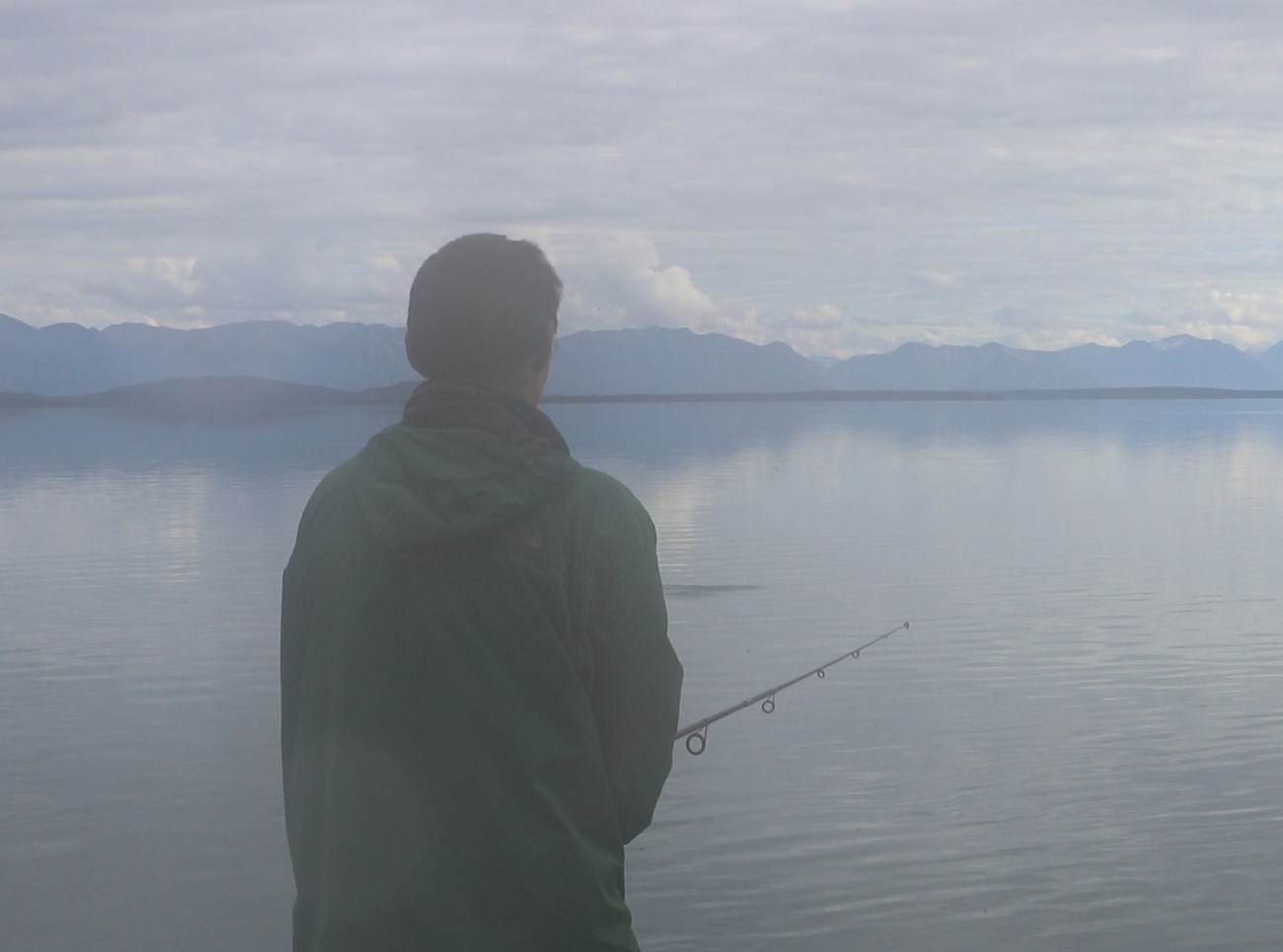
National Park Service photograph, Deborah Coble
Conclusion
Most of the residents interviewed recalled the practice of sharing the first salmon caught with the entire village. Whoever caught the first salmon would host a community gathering where everyone was given a taste of the fish, even if it was only a small bite or a sip of the broth. This project offers a window into the place salmon have in the lives of Dena'ina Athabascans as both a vibrant symbolic element to their culture and a central source of nutrition. The study offers vital information based on first-hand knowledge about fish resources in the Nondalton area. It also confirms and reinforces data gathered by fish biologists working in the region. Relationships between Nondalton residents and NPS researchers were strengthened through their cooperative efforts, and new areas for biological and traditional ecological knowledge research were identified through the process.Acknowledgments
This research was supported by the U.S. Fish and Wildlife Service, Fisheries Information Services. The related project to document traditional ecological knowledge was undertaken by the Nondalton Tribal Council in partnership with Lake Clark National Park and Preserve. Partnerships of this kind are encouraged in Section 809 of ANILCA.This project would not have been possible without the generosity of the following Nondalton residents who participated in the interviews and shared their time and knowledge with the interviewers: Pete Koktelash, Nastasia Zackar, Mary Hobson, Agnes Cusma, Dolly Hobson, Nick Carltikoff, Sr., Andrew Balluta, Mike Delkittie, Olga Balluta, Gladys Evanoff, Bill Trefon Sr., Martha Trefon, George Alexie, Liz Balluta, Darlene Nolan, Clara Trefon, and Melvin Trefon.
Community Perspectives
"ANILCA probably changed the Alaska and the rural lifestyle more than any other legislation ever passed. One of the most Important things that It did for rural Alaska residents Is protect the subsistence way of life. It was recognized that those practldng a subsistentce llfestyle are in harmony with the natural systems and should be protected. This is the culture of rural Alaska and is vital to those who live here...It is a lifestyle that is protected, not a right given to particular Individuals."
- Suzanne McCarthy Subsistence ResourceCommission. Coordinator for Copper Basin Campus of Prince WIiiiam Sound Community College, Wrangell-St. Elias National Park and Preserve, Gakona
"Subsistence is so important in our region, we were the authors of the subsistence provisions In ANILCA and led that fight in Congress. For our region the provisions that provide and manage for subsistence in ANILCA have been a godsend because 60% of the lands In our region are in federal hands. The processes we go through to get the regulations have been [in] our favor because under the state system we were not getting what we wanted. The processes established for regulations under ANILCA through the RAC and SRC commissions is working very well and we do not want to see any changes. Both commissions work very hard to propose regulations that flt our needs and at the same time provide for conservation."
- Willie Goodwin, Special Assistant to Superintendent, Western Arctic Parklands, Kotzebue
"When the lands were drawn in 1978 for conservation units, and when Congress passed the ANILCA legislation, local people were very concerned. Would we be excluded from use of areas that are now parks? The first managers came with "outside" non-consumptive ideas. We had many contentious meetings. I was not inclined to enter the political arena, but to protect our life ways, I did. I read the ANILCA law and ... found that Congress had indeed made protections for rural subsistence users, and provided for a meaningful role in management. I began advocating for the legal use of resources using the law .... Over the past 25 years I have found that once managers and subsistence users have used the law, it works. The promises Congress made to protect rural subsistence users on federal lands is now being done ..."
- Jack Reakoff, Vice Chair Subsistence Resource Commission, Subsistence User, Brooks Range, Wiseman
"In the last several years, I've come to appreciate the [Subsistence Resource Commission's] work. At first, we didn't really think of our work as important but over the years I've come to see its importance. It's a time-consuming thing for a subsistence person, but we've laid some real groundwork and it's good to see agencies recognize Native knowledge of things. Subsistence has always been a cultural issue...We get and use animals differently today, but they mean the same thing. Subsistence is our lifestyle and birthright and privilege."
- Melvin Trefon, Subsistence Resource Commission, Nondalton
References
Alaska Department of Fish and Game (ADF&G). 2002.
Alaska Department of Fish and Game Division of Commercial Fisheries Annual Report, 2001, Bristol Bay Area.
Alaska Department of Fish of Game. Anchorage, Alaska.
Behnke, Steven R. 1982.
Wildlife Utilization and the Economy of Nondalton. Technical Paper Number 47.
Alaska Department of Fish and Game, Subsistence Division. Dillingham, Alaska.
Bristol Bay Native Association. 2002.
Bristol Bay, Alaska, Comprehensive Economic Development Strategy.
Bristol Bay Native Association. Dillingham, Alaska.
Colt. Steve. 1999.
Salmon Fish Traps in Alaska.
University of Alaska Anchorage, Institute of Social and Economic Research. Anchorage, Alaska.
Ellanna, Linda, and Andrew Balluta. 1992.
Nuvendaltin Quht'ana: The People of Nondalton.
Smithsonian Institution Press. Washington, D.C.
Poe, Robert, and Donald Rogers. 1984.
Newhalen River Adult Salmon Enumeration Program: FRI Final Report Contract 14007-JJ0011.
Stone and Webster Engineerihg Corp. FRI-UW-8415.
Stickman, Karen, Andrew Balluta, Mary McBurney, and Dan Young. 2003.
K'ezghlegh: Nondalton Traditional Ecological Knowledge of Freshwater Fish.
U.S. Fish and Wildlife Service, Fisheries Information Services (project 01-075).
Townsend, Joan Broom. 1965.
Ph.D. dissertation.
Ethnohistory and Culture Change of the lliamna Tanaina.
University of California-Los Angeles. Los Angeles.
Woody, CA. 2004.
Population monitoring of sockeye salmon from Lake Clark and the Tazimina River; Kvichak River watershed, Bristol Bay, Alaska, 2000-2003. Final Report 01-095.
U.S. Fish and Wildlife Service Office of Subsistence Management. Anchorage, Alaska
Alaska Department of Fish and Game (ADF&G). 2002.
Alaska Department of Fish and Game Division of Commercial Fisheries Annual Report, 2001, Bristol Bay Area.
Alaska Department of Fish of Game. Anchorage, Alaska.
Behnke, Steven R. 1982.
Wildlife Utilization and the Economy of Nondalton. Technical Paper Number 47.
Alaska Department of Fish and Game, Subsistence Division. Dillingham, Alaska.
Bristol Bay Native Association. 2002.
Bristol Bay, Alaska, Comprehensive Economic Development Strategy.
Bristol Bay Native Association. Dillingham, Alaska.
Colt. Steve. 1999.
Salmon Fish Traps in Alaska.
University of Alaska Anchorage, Institute of Social and Economic Research. Anchorage, Alaska.
Ellanna, Linda, and Andrew Balluta. 1992.
Nuvendaltin Quht'ana: The People of Nondalton.
Smithsonian Institution Press. Washington, D.C.
Poe, Robert, and Donald Rogers. 1984.
Newhalen River Adult Salmon Enumeration Program: FRI Final Report Contract 14007-JJ0011.
Stone and Webster Engineerihg Corp. FRI-UW-8415.
Stickman, Karen, Andrew Balluta, Mary McBurney, and Dan Young. 2003.
K'ezghlegh: Nondalton Traditional Ecological Knowledge of Freshwater Fish.
U.S. Fish and Wildlife Service, Fisheries Information Services (project 01-075).
Townsend, Joan Broom. 1965.
Ph.D. dissertation.
Ethnohistory and Culture Change of the lliamna Tanaina.
University of California-Los Angeles. Los Angeles.
Woody, CA. 2004.
Population monitoring of sockeye salmon from Lake Clark and the Tazimina River; Kvichak River watershed, Bristol Bay, Alaska, 2000-2003. Final Report 01-095.
U.S. Fish and Wildlife Service Office of Subsistence Management. Anchorage, Alaska
Last updated: September 7, 2017
